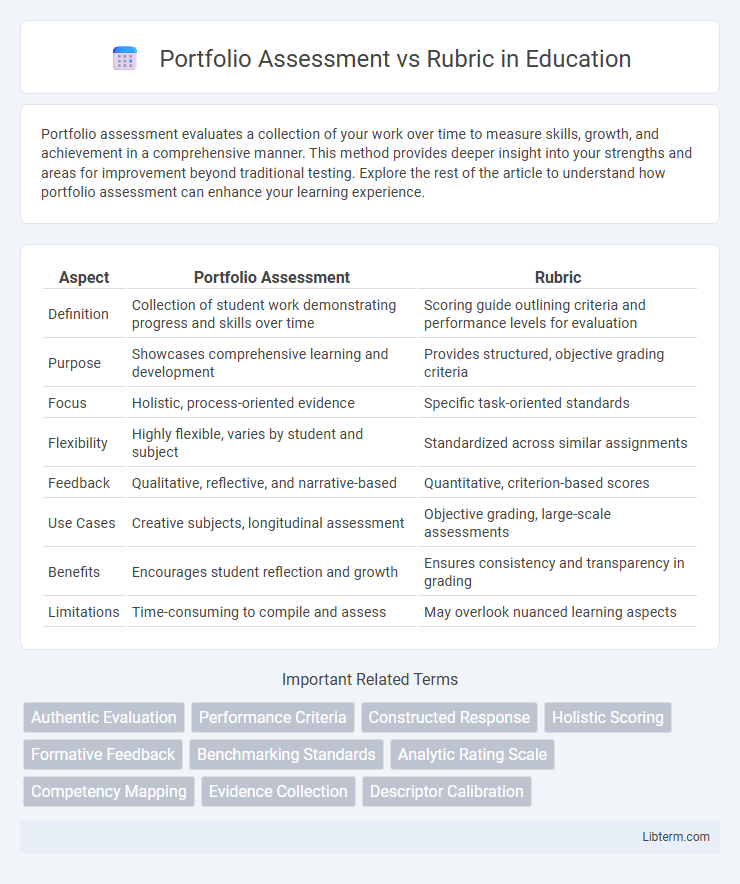Portfolio assessment evaluates a collection of your work over time to measure skills, growth, and achievement in a comprehensive manner. This method provides deeper insight into your strengths and areas for improvement beyond traditional testing. Explore the rest of the article to understand how portfolio assessment can enhance your learning experience.
Table of Comparison
| Aspect | Portfolio Assessment | Rubric |
|---|---|---|
| Definition | Collection of student work demonstrating progress and skills over time | Scoring guide outlining criteria and performance levels for evaluation |
| Purpose | Showcases comprehensive learning and development | Provides structured, objective grading criteria |
| Focus | Holistic, process-oriented evidence | Specific task-oriented standards |
| Flexibility | Highly flexible, varies by student and subject | Standardized across similar assignments |
| Feedback | Qualitative, reflective, and narrative-based | Quantitative, criterion-based scores |
| Use Cases | Creative subjects, longitudinal assessment | Objective grading, large-scale assessments |
| Benefits | Encourages student reflection and growth | Ensures consistency and transparency in grading |
| Limitations | Time-consuming to compile and assess | May overlook nuanced learning aspects |
Introduction to Portfolio Assessment and Rubric
Portfolio assessment evaluates a student's learning progress and achievements by collecting a comprehensive compilation of their work over time, providing a holistic view of skills and understanding. Rubrics serve as detailed scoring guides that define specific criteria and performance levels for assessing individual assignments or projects, ensuring consistent and objective evaluation. Both tools enhance educational assessment by clarifying expectations and measuring student performance through structured, evidence-based methods.
Defining Portfolio Assessment
Portfolio assessment is a comprehensive evaluation method that collects a student's work over time to demonstrate learning progress, skills, and achievements across various subjects. It provides a holistic view of student performance by showcasing multiple examples of work, reflective entries, and self-assessments rather than scoring a single test or assignment. Unlike rubrics, which are scoring guides with specific criteria and levels of performance, portfolio assessment emphasizes growth, creativity, and depth of understanding through diverse evidence.
What is a Rubric?
A rubric is a scoring tool used to evaluate student performance based on predetermined criteria and levels of proficiency, providing clear expectations for assignments or projects. It breaks down the grading process into specific components such as organization, content, and creativity, each with defined descriptions for different achievement levels. Rubrics enhance objectivity and consistency in assessment by offering detailed guidelines that help both instructors and students understand how grades are determined.
Key Differences Between Portfolio Assessment and Rubric
Portfolio assessment emphasizes the collection and evaluation of an individual's body of work over time, showcasing growth, skills, and achievements across various tasks or projects. Rubrics provide a structured scoring guide with predefined criteria and performance levels to objectively assess specific assignments or competencies. The key difference lies in portfolios offering a holistic, longitudinal view of student progress, while rubrics deliver standardized, criterion-based evaluations for specific learning outcomes.
Advantages of Portfolio Assessment
Portfolio assessment offers a comprehensive evaluation by showcasing a learner's growth, skills, and achievements over time, providing a richer, more personalized insight than traditional rubrics. It supports diverse learning styles and allows for self-reflection, fostering deeper engagement and continuous improvement. This method also captures a wider array of competencies, including creativity and critical thinking, which may not be easily quantified by rubric criteria.
Benefits of Using Rubrics
Rubrics provide clear, consistent criteria that streamline grading and enhance transparency for students, making expectations more understandable and manageable. They also facilitate objective assessment by minimizing subjective bias and ensuring alignment with learning goals. Educators benefit from efficient feedback delivery and easier tracking of student progress across diverse competencies.
Limitations of Portfolio Assessment
Portfolio assessment often faces limitations such as subjectivity in evaluation, inconsistent criteria across different assessors, and the time-intensive nature of compiling and reviewing diverse student work. Unlike rubrics, which provide clear, standardized metrics for grading, portfolios can lack uniformity, making it challenging to ensure reliable and comparable assessments. Furthermore, portfolios may not effectively capture a student's mastery of specific learning objectives due to their broad and varied content.
Drawbacks of Rubric-Based Evaluation
Rubric-based evaluation often limits the scope of student creativity by enforcing strict criteria that may not capture the full depth of learner understanding. This method can lead to a narrow assessment focus, emphasizing quantitative scores over qualitative insights, which reduces flexibility in evaluating diverse skills and complex projects. The rigid structure of rubrics may also discourage critical thinking and personalized feedback, potentially undermining meaningful educational growth.
Choosing the Right Assessment Method
Portfolio assessment offers a comprehensive view of a student's progress by showcasing diverse work samples over time, while rubrics provide clear, consistent criteria for evaluating specific tasks or performances. Choosing the right assessment method depends on the learning objectives, with portfolios best suited for holistic, developmental insights and rubrics ideal for standardized, objective grading. Aligning assessment choice with instructional goals enhances accuracy and supports targeted feedback in educational settings.
Conclusion: Portfolio Assessment vs Rubric
Portfolio assessment offers a comprehensive view of a student's progress by showcasing diverse work samples, while rubrics provide clear, consistent criteria for evaluating specific tasks. Combining portfolios with rubrics enhances both qualitative insights and objective grading standards, leading to a balanced, effective assessment strategy. Educators benefit from this integrated approach by addressing varied learning styles and improving feedback accuracy.
Portfolio Assessment Infographic

 libterm.com
libterm.com